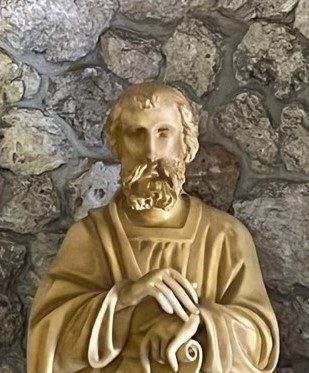Feast Day of St Mark – Tuesday, April 25th
Who was St. Mark the Evangelist? Early Christian tradition attributed each Gospel to an author who was either an Apostle, or who was closely linked to the Apostles. St. Mark was a disciple of St. Peter and he wrote his Gospel based on Peter’s preaching in Rome.
St. Mark the Evangelist is traditionally identified with the mark who is often mentioned in Acts and his Jewish name was actually John – (see Acts 12:12, 25. Verse 12 :”When he realized this, he went to the house of Mary, the mother of John who is called Mark, where there were many people gathered in prayer.” and verse 25:”After Barnabas and Saul completed their relief mission, they returned to Jerusalem,* taking with them John, who is called Mark.”).
St. Mark also served as an assistant on St. Paul’s first missionary journey (see Acts 13:5)
Later tradition is that St. Mark established the church in Alexandria in Egypt and that he became the first bishop of Alexandria. His first readers were probably Roman Christians who were being persecuted by Emperor Nero.
For most of Church history, Mark’s gospel was neglected and used rarely in preaching or doctrinal exposition. Not one commentary was written on this Gospel until the early middle ages, possibly because there was a view that originated with St. Augustine that the gospel was an abbreviated version of Matthew. Indeed, of the 661 verses of Mark, 90% are reproduced in the Gospel of Matthew and 55% are reproduced in the Gospel of Luke.
By the 20th century, however, it was widely held that the Gospel of Mark was the most ancient Gospel and was used by both Matthew and Luke. Oddly, for centuries most of the Sunday Gospel readings were from the Gospel of Matthew. With the renewal of the liturgy after Vatican II there was a restructuring and the Gospel of Mark became the Cycle B Gospel, read on most Sundays from January to November every 3rd year. The weekday readings feature the Gospel of Mark even more.
Why is there a winged lion in images of St. Mark? According to an ancient legend, an angel appeared to St. Mark in the image of a winged Lion, when he was taking refuge during a storm in the city of Venice. We have a statue of this lion outside the Marian Shrine. Also there is a beautiful mosaic above the double doors in the front of the church. If you haven’t noticed this, please take time to look at the mosaic. Also there is a statue of St. Mark on the right side of the sanctuary, with a lion there as well.
How did he die? When St. Mark returned to Alexandria after serving with St. Paul, the pagans of the city resented his efforts to turn the Alexandrians away from the worship of their traditional gods and in AD 68, they placed a rope around his neck and dragged him through the streets until he was dead.

